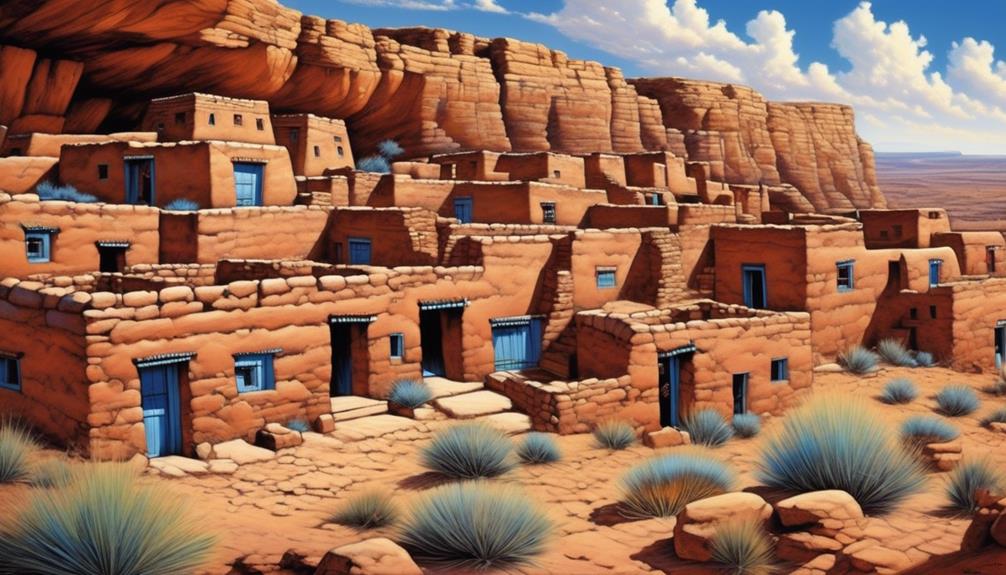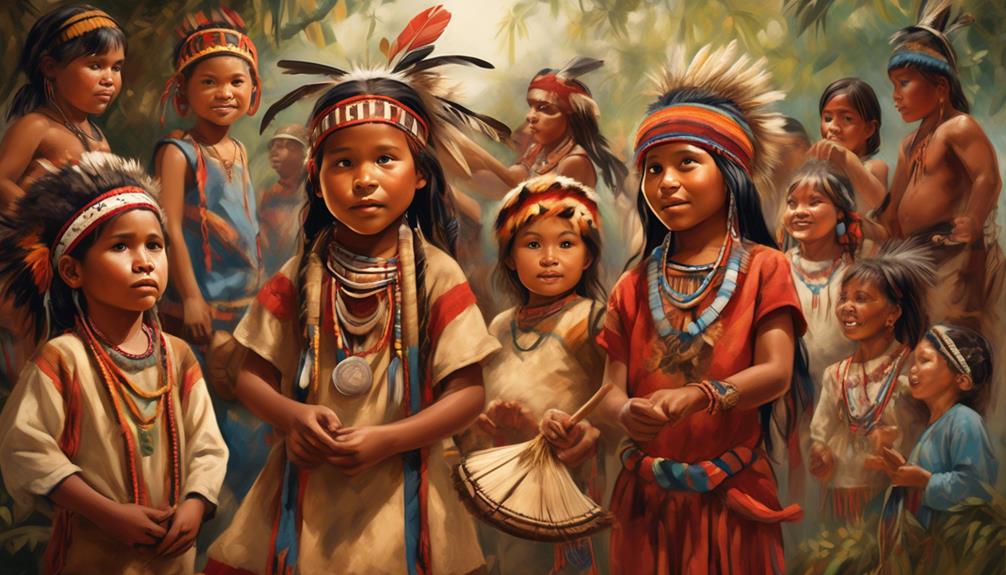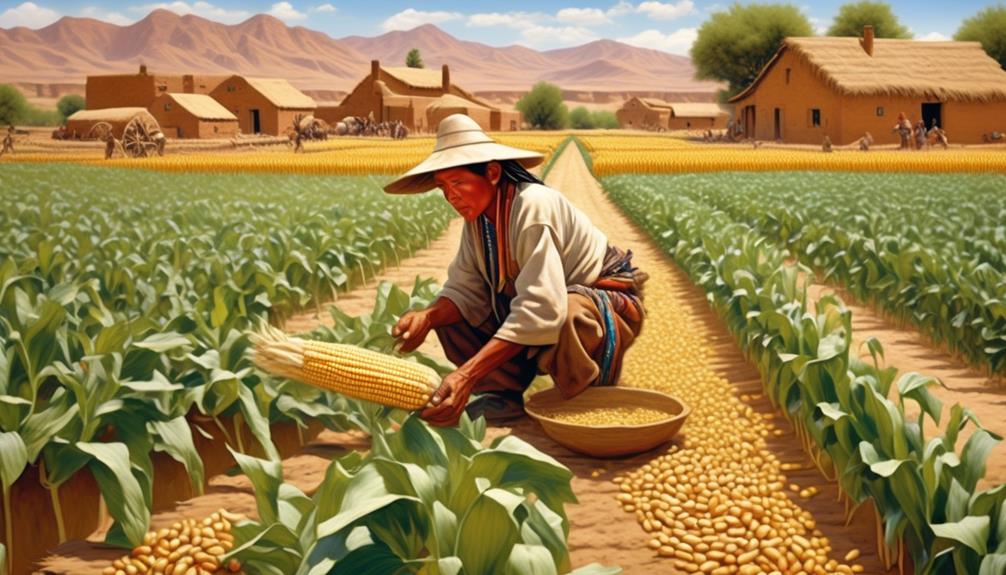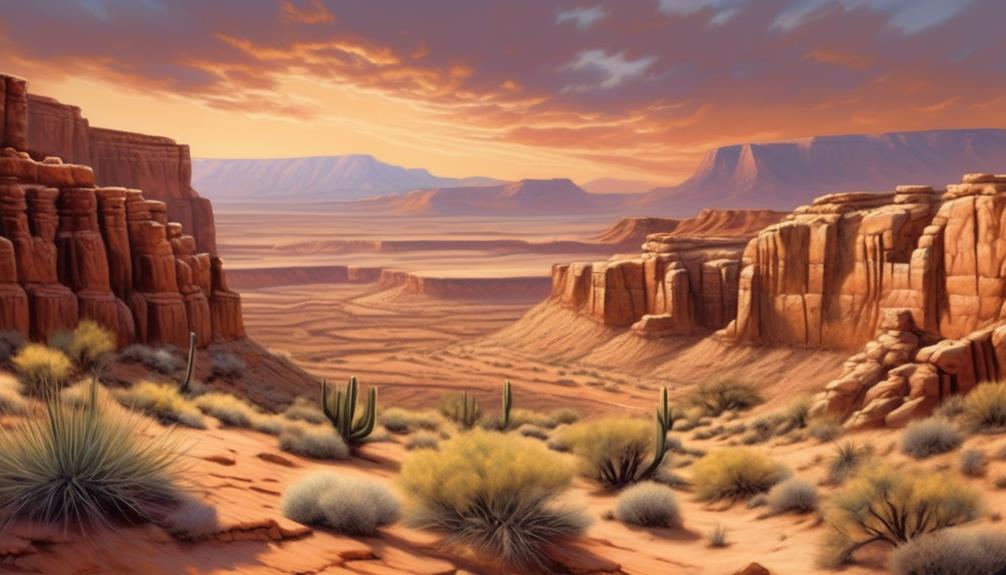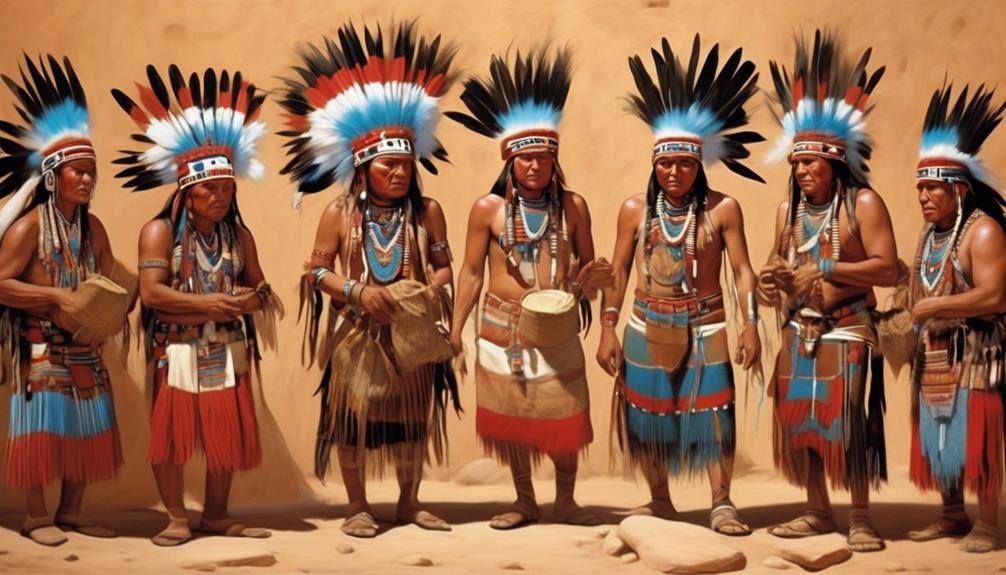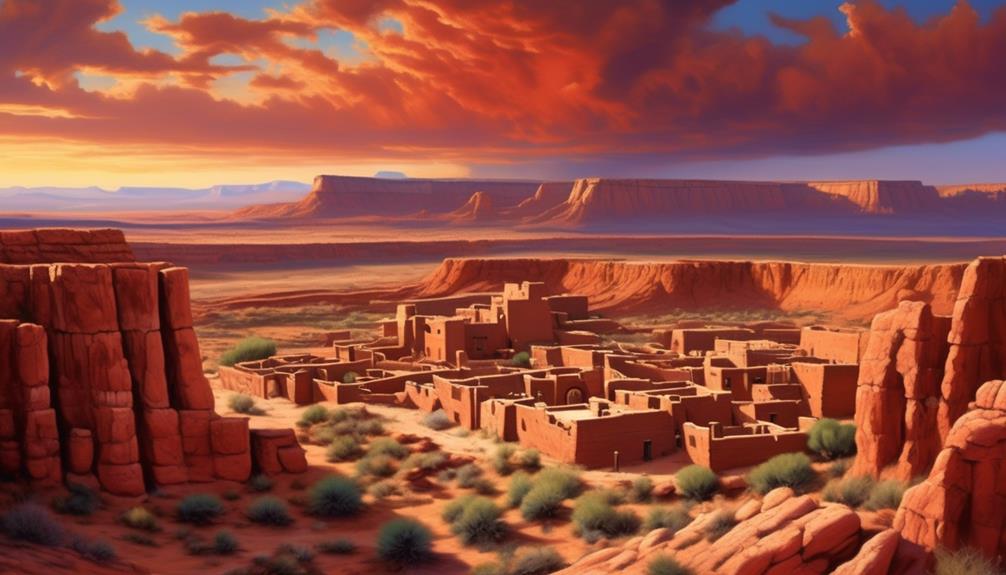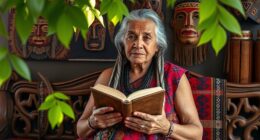It is fascinating how often we overlook the rich history and cultural significance of indigenous tribes in our own country. For instance, many people may not realize that the Hopi Tribe is one of the oldest Native American tribes to have settled in what is now the United States.
But where exactly did the Hopi Tribe call home? Well, let's just say that their state of residence might surprise you. Curious to learn more about the fascinating history and geographic location of the Hopi Tribe? Keep reading to uncover the state that became the backdrop for their unique culture and traditions.
Key Takeaways
- The Hopi Tribe is located in northeastern Arizona.
- The Hopi Tribe has a deep connection to their traditional beliefs and practices, which are rooted in reverence for the land.
- The Hopi Tribe resides on three mesas in an arid climate with rugged terrain, and their agricultural practices heavily rely on natural resources.
- The preservation of Hopi culture and heritage is a priority for the tribe, with a focus on educating youth and continuing traditional practices.
Hopi Tribe Origins and Settlement
The Hopi tribe's origins and settlement can be traced back to the ancient Pueblo people who inhabited the Southwest region of what's now the United States. The Hopi tribe migration led them to settle in the area known as the Hopi Mesas in northeastern Arizona, where they've resided for over a thousand years.
The Hopi people have a deep connection to their traditional beliefs, which are rooted in their reverence for the land and their agricultural way of life. Central to their traditional beliefs is the concept of Katsina, which are spirit messengers that are integral to their religious and cultural practices. The Hopi tribe's migration and settlement patterns were influenced by their spiritual beliefs and their commitment to living in harmony with nature.
The Hopi tribe's traditional beliefs also shape their understanding of the world and their place within it. They believe in the importance of upholding their sacred rituals and ceremonies to maintain balance and harmony in the world. The Hopi people continue to pass down their traditional beliefs and practices from generation to generation, reinforcing the continuity of their cultural identity and spiritual connection to the land.
Geographic Location of the Hopi Tribe
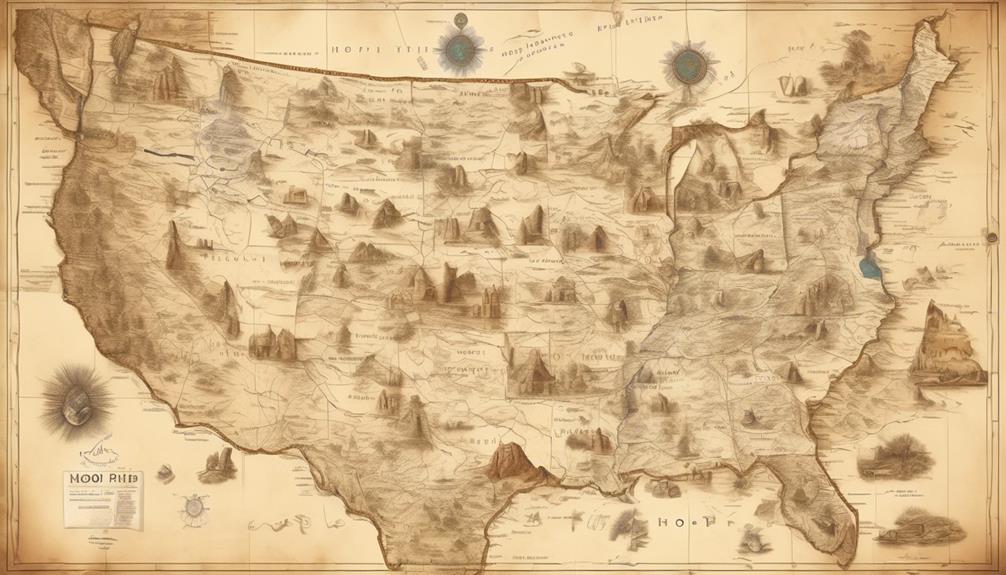
Nestled atop three mesas in northeastern Arizona, the Hopi tribe's geographic location has been integral to their cultural and spiritual connection to the land for over a thousand years.
The Hopi reservation covers approximately 2,531 square miles within the geographical boundaries of northeastern Arizona. This area is characterized by its arid climate and rugged terrain, providing the Hopi tribe with a unique environment that has shaped their way of life.
The natural resources within this region, such as water from springs and washes, have been crucial for sustaining the agricultural practices that are central to the Hopi way of life. These resources have allowed the Hopi people to cultivate corn, beans, and squash, forming the basis of their traditional diet and cultural practices.
Additionally, the land's natural formations, including canyons and mesas, hold deep spiritual significance for the Hopi tribe, playing a vital role in their ceremonies and religious beliefs.
The Hopi tribe's geographic location hasn't only influenced their physical surroundings but has also profoundly impacted their cultural identity and spiritual connection to the land.
Historical Significance of Hopi Land
Tapping into the rich history of the Hopi tribe's land reveals a tapestry of cultural traditions and ancestral legacies that have endured for centuries. Hopi land holds immense historical significance, serving as the cradle of the tribe's ancestral traditions. The land is deeply intertwined with the Hopi people's identity, spirituality, and way of life. It has been the stage for ancient ceremonies, agricultural practices, and the preservation of oral histories passed down through generations.
The historical significance of Hopi land is underscored by the tribe's unwavering commitment to preserving age-old customs and beliefs. The landscape itself is imbued with spiritual meaning, with each mesa, canyon, and spring holding profound significance in Hopi cosmology. The land hasn't only been a physical home for the tribe but also a spiritual sanctuary where sacred rites and ceremonies have been performed for centuries.
The enduring legacy of Hopi land is a testament to the tribe's resilience and deep-rooted connection to their ancestral traditions. It continues to serve as a living testament to the rich tapestry of the Hopi people's history and cultural heritage.
Modern Challenges Facing the Hopi Tribe
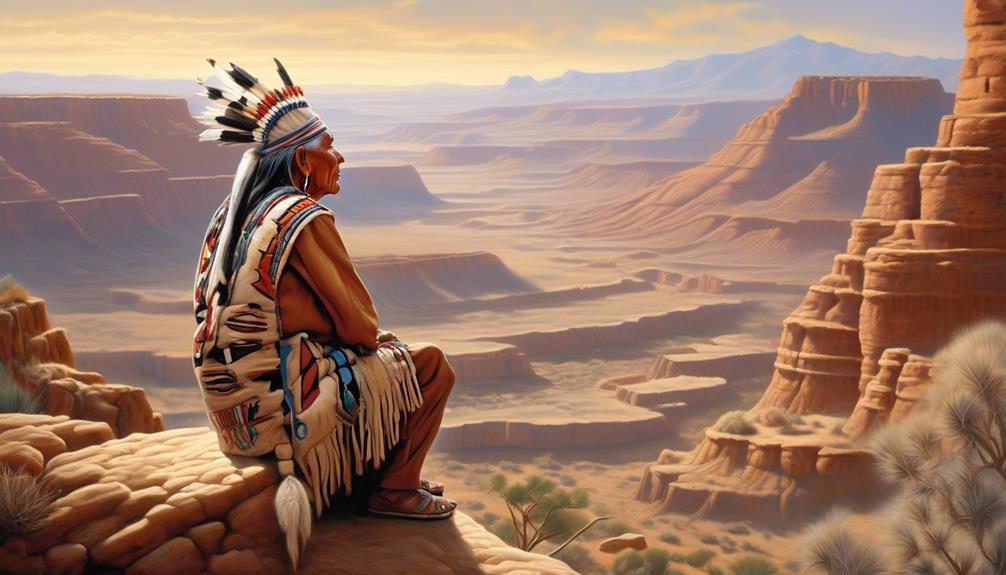
Facing the modern world presents the Hopi Tribe with a new set of challenges as we strive to preserve our ancestral traditions and way of life. In our efforts to maintain our cultural identity and sovereignty, we're confronted with various modern-day obstacles.
- Socioeconomic Struggles
- Limited Economic Opportunities: The Hopi Tribe faces high unemployment rates and limited access to economic development opportunities, leading to financial hardships for many community members.
- Healthcare Disparities: Access to quality healthcare, especially mental health services, remains a significant challenge for the Hopi Tribe, impacting the overall well-being of our people.
- Environmental Conservation
- Water Resource Management: As we continue to face water scarcity in the arid Southwest, the Hopi Tribe is actively engaged in efforts to conserve and protect our precious water resources for current and future generations.
- Land Use and Preservation: Balancing the need for economic development with the preservation of our sacred lands is an ongoing challenge, requiring thoughtful planning and sustainable practices.
Navigating these contemporary challenges while upholding our cultural heritage is vital for the continued resilience and prosperity of the Hopi Tribe.
Preservation of Hopi Culture and Heritage
Preserving our Hopi culture and heritage is a fundamental aspect of our identity as a tribe, guiding our actions and decisions for the benefit of future generations. Cultural preservation is vital to us, as it ensures that our traditions, beliefs, and values are passed down through the ages. Our traditional practices, such as the performance of ceremonies like the Niman Kachina, the Powamu, and the Snake Dance, are deeply rooted in our history and spirituality. It's crucial for us to uphold and protect these customs, as they form the cornerstone of our cultural identity.
To preserve our cultural heritage, we actively engage in activities that promote the continuation of traditional practices. This includes educating our youth about the significance of our customs and involving them in ceremonial activities. Additionally, we emphasize the importance of oral tradition, ensuring that our stories and legends are passed on orally from one generation to the next.
Through these efforts, we strive to maintain the richness of our cultural heritage, allowing it to thrive and endure for the generations to come.
Frequently Asked Questions
What Are the Traditional Hopi Beliefs and Ceremonies?
We honor the traditional Hopi beliefs and ceremonies that are rooted in deep spiritual connections to the land and their ancestors. These practices are integral to our cultural preservation and identity.
Despite modern challenges, the Hopi people continue to adapt these traditional practices to ensure their continuity and relevance.
Hopi ceremonies are a vital part of our community, fostering a strong sense of unity and spirituality.
How Has the Hopi Tribe Adapted to Modern Society While Maintaining Their Cultural Identity?
Adapting to modern society while maintaining our cultural identity is crucial for the Hopi tribe. Cultural preservation is central to our way of life, and we've integrated our traditions into modern practices.
Through community integration, we've found ways to uphold our values while also participating in the wider society. This balance allows us to honor our heritage while also thriving in the contemporary world.
What Are Some Traditional Hopi Crafts and Artwork?
We have a rich tradition of crafts and artwork. Hopi pottery, Kachina dolls, basket weaving, silver jewelry, textile art, beadwork, carving techniques, and painting styles are all part of our cultural heritage.
These crafts and artwork are integral to our identity and have been passed down through generations. They showcase our creativity, spirituality, and connection to the land. Each piece holds deep meaning and reflects our values and beliefs.
What Is the Current Population of the Hopi Tribe and How Has It Changed Over Time?
Well, the current population of the Hopi tribe has seen some interesting trends. Over time, there have been demographic changes, affecting the tribe's size.
Economic development and educational opportunities have also played a role in shaping these numbers. It's a complex picture, but one thing's for sure: the population of the Hopi tribe has evolved in response to various factors, creating a rich tapestry of history and modern-day realities.
Are There Any Ongoing Disputes or Conflicts Involving the Hopi Tribe and Neighboring Communities or Governments?
Yes, the Hopi Tribe has ongoing land disputes and sovereignty issues with neighboring communities and governments.
These conflicts often stem from differing interpretations of historical land treaties and resource rights.
As a result, we continue to engage in discussions and legal battles to protect our ancestral lands and maintain our sovereignty.
These disputes are complex and ongoing, and we're committed to finding peaceful and just resolutions.
Conclusion
So, after all this time, you might be surprised to learn that the Hopi tribe actually lived in a state of harmony and balance, not just a physical state. Their ancient wisdom and cultural traditions continue to thrive, despite the challenges they face.
It's ironic that a tribe with such a deep connection to the earth and their ancestors is now fighting to preserve their way of life in a world that often seems to have forgotten its own roots.
Mary is a passionate writer who brings creativity and a fresh perspective to our team. Her words have the power to captivate and inspire, making her an essential contributor to our content. Mary’s commitment to storytelling and dedication to promoting Indigenous culture ensures that her work touches the hearts of our readers. We’re fortunate to have her as part of our team.
